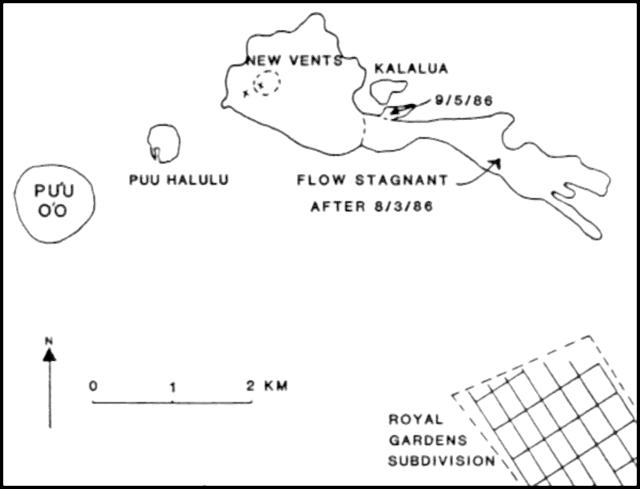Report on Kilauea (United States) — August 1986
Scientific Event Alert Network Bulletin, vol. 11, no. 8 (August 1986)
Managing Editor: Lindsay McClelland.
Kilauea (United States) Lava shield continues to grow
Please cite this report as:
Global Volcanism Program, 1986. Report on Kilauea (United States) (McClelland, L., ed.). Scientific Event Alert Network Bulletin, 11:8. Smithsonian Institution. https://doi.org/10.5479/si.GVP.SEAN198608-332010
Kilauea
United States
19.421°N, 155.287°W; summit elev. 1222 m
All times are local (unless otherwise noted)
Episode 48 (E-48). Activity continued through August into mid-September, building a large shield ~3 km NE of Pu`u `O`o. By mid-September, the shield had grown to 1.5 km in diameter and 41 m high. Overflows filled low areas, and lava tubes fed short pahoehoe flows to its margin, with the longest flows extending only 2 km SE from the vent. Most of the shield was composed of pahoehoe flows but there was some aa lava at the margin. Upwelling was almost continuous from one or both of the two active vents, and low spattering has been occasionally observed. A lava pond had developed on the flat top of the shield by late August, and had grown to 100 m in diameter by 1 September (figure 46).
Low-level tremor centered in the middle East rift zone continued with only slight changes in amplitude. Summit tilt remained unchanged through August (figure 45).
Pu`u `O`o vent remained inactive, although the conduit was incandescent and there was a slight gas plume. The magma column that had been present in the conduit during past interphase periods was no longer visible.
Geological Summary. Kilauea overlaps the E flank of the massive Mauna Loa shield volcano in the island of Hawaii. Eruptions are prominent in Polynesian legends; written documentation since 1820 records frequent summit and flank lava flow eruptions interspersed with periods of long-term lava lake activity at Halemaumau crater in the summit caldera until 1924. The 3 x 5 km caldera was formed in several stages about 1,500 years ago and during the 18th century; eruptions have also originated from the lengthy East and Southwest rift zones, which extend to the ocean in both directions. About 90% of the surface of the basaltic shield volcano is formed of lava flows less than about 1,100 years old; 70% of the surface is younger than 600 years. The long-term eruption from the East rift zone between 1983 and 2018 produced lava flows covering more than 100 km2, destroyed hundreds of houses, and added new coastline.
Information Contacts: C. Heliker, HVO.


